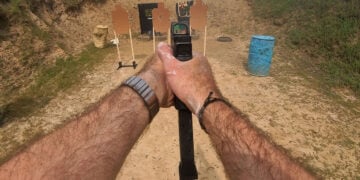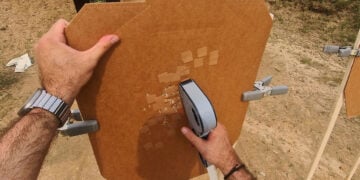When it comes to revolver shooting there are a few ways to accomplish the reload, unlike its semiauto counterpart which basically has to be loaded with an already loaded magazine. With the revolver there are moon clips, speedloaders, speed strips, 2x2x2 pouches, et al. You can also just load loose rounds. While probably not the recommended method for defensive purposes, it is one of those things that revolver guys need to know how to do, just in case. It is not unheard of to have speedloaders fail and dump the rounds previously held in the speedloader into a pocket, if that is how the speedloader is carried. It might be that we don’t have a way to prepackage our reload so we grab a few rounds and drop them in a pocket. Not advisable, but possible.
My personal preference is to have all of the rounds closer to the revolver, and the revolver open, so I use a technique that is actually from the old dump pouch days. The goal is to have access to all of the rounds to be loaded at once, while also having access to the open revolver cylinder. It is possible to hold the revolver in one hand, the rounds in the other hand and sort of funnel them into the cylinder. The only problem is doing that is really cumbersome and fumble prone.
The way that I prefer is to have the revolver with the cylinder open, and all of the rounds to be loaded, held in the same hand. Doing this allows my dominant hand to load each round individually, but has all of the rounds to be loaded close enough to the cylinder that it is comparatively fast. This is primarily accomplished by how the revolver is held, which opens up the palm to hold the ammunition that is to be loaded in the same hand as the gun. Using this reload technique makes it easier for me to move around if I need to, and the rounds are staged close enough to the cylinder that it can be done without looking for the most part.
Step 1: Once the empty shell casings have been ejected from the cylinder per your preferred method, rotate the revolver so that the muzzle is pointed at the ground with the cylinder open, and place the revolver in the dominant hand with a firing grip.
Step 2: (For a shooter that reloads with the support hand and carries ammunition on the support side of the body, retrieve the rounds before starting this next part and hold them in the palm of the support hand) For a shooter that reloads with the dominant hand, create a V with the index and ring finger of the left hand (assuming a right handed shooter). Place the ejector rod in the V of the two fingers, and the thumb should go over the top of the cylinder and through the frame of the revolver where the cylinder would normally be and index the revolver with the butt of the revolver away from your body so that the bulk of the revolver does not block easy access to the open cylinder. It works out a little different for the left handed shooter, as the thumb will instead wrap around the bottom of the frame first, and then curl into the space typically occupied by the cylinder. It ends up the same though. The cylinder and palm will end up on the left side of the revolver itself, giving easy access with the left hand to reload the cylinder.

Step 3: Retrieve the loose rounds with the dominant hand and dump them into the palm of the support hand that is also holding the revolver.
Step 4: Load individual rounds into the charge holes with the dominant hand. This can be done while maintaining some downrange awareness if needed. Once the reload is complete, close the cylinder and get back to work as needed. If outgoing fire is required while the reload is still in process, the reload can be abandoned and charge on with whatever happens to be in the cylinder. It is important to understand that a revolver with one or two rounds in it is still a loaded revolver. The rounds left in the support hand can either be dropped, held in the support hand and the shooting done one handed, or returned to the pocket. If the need for outgoing fire is urgent, it implies that the bad guy is in close proximity, so I lean towards just shooting one handed, but there are options here.

This is not a technique I would want to rely on as a primary reloading method because of how slow it is, but sometimes we have to do things that we don’t want to do. It is cheap insurance in case Murphy decides to be our best friend that day, and is something we revolver guys need to know how to do with at least a small measure of skill.









